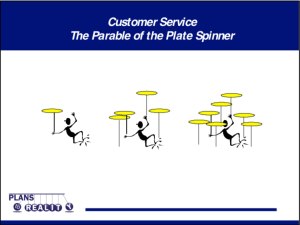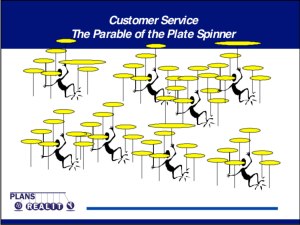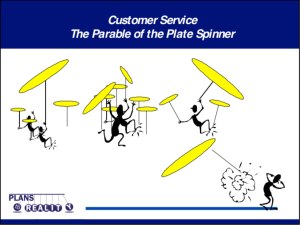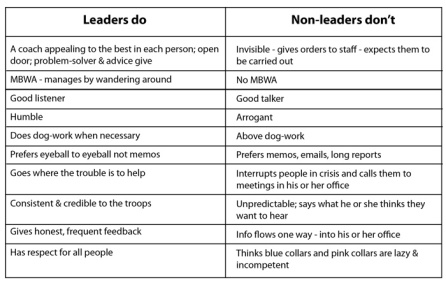 If I offered you one free ticket to a presentation given by an acknowledged world authority on each of the following topics, which presentation would you opt to attend? Remember, you can only go to one of them. The choices are:
If I offered you one free ticket to a presentation given by an acknowledged world authority on each of the following topics, which presentation would you opt to attend? Remember, you can only go to one of them. The choices are:
- Teams and Teamwork
- Leadership
- Management of Change
- Organisational Alignment
- Communication
- Employee Engagement
I think it’s a fair bet that you didn’t choose Organisational Alignment – not really sexy, is it? No doubt you’ve said to yourself at some stage or other – “I wish my employees were more engaged” or “we need to manage change much better than we do” or “our teams program seems to be running out of steam” but I doubt if you have ever said – “We need much greater organisational alignment”
Yet without organisational alignment every other success factor suffers and the organisation’s ability to bring the enterprise strategy to fruition will fail.
Most observers regard Organisational Alignment as something that relates only to the employees of an organisation. They use a three part definition as follows.
■ Everyone understands where the organisation is now (current reality)
■ Everyone understands the destination (goal) and the journey (strategies to get there)
■ Everyone understands their role in getting there
Enterprise Alignment precedes Organisational Alignment
However before the staff of an organisation can be aligned, the organisation itself needs to be aligned as well. Management has to determine the current reality; management has to agree an overall goal; management has to develop the strategies to achieve it and, lastly management must allocate responsibilities to everyone in the organisation so each may play their role in its implementation. And at the core of this whole exercise is a matching process – let’s call it Enterprise Alignment. It’s the matching of the current and future trends and characteristics of the organisation’s external environment in which it operates with its current and future resources and expertise.
In short Enterprise Alignment is a prerequisite to Organisational Alignment.
Let me illustrate this with two examples. The first involves skeins of migrating geese so beloved by management consultants as exemplars of teamwork. It’s a powerful, emotive analogy but the basis of their performance and subsequent teamwork is Organisational Alignment. The geese can only demonstrate the essence of teamwork because the members of the skein agree where they are now, share a common objective, know the direction in which they need to fly and understand the roles each need to play when the skein is in flight. Even more fundamentally, the need to migrate from A to B at particular times of the year is hard wired into geese. Yet such is their sensitivity to short term climatic change, they will alter both the timing of their migrations and their route according to climatic conditions. This is their version of Enterprise Alignment.
The second example also concerns flight – namely the Boeing 787-9’s recently ordered by Qantas as a key strategy in the rejuvenation of their International division. Qantas CEO Alan Joyce set three criteria as prerequisites for ordering Boeing’s Dreamliner – Qantas International had to be returned to a position of sustainable profitability; the Company had to be capable of paying down its $1 billion of debt and the Qantas long-haul pilots union had to accept changes to the terms and conditions of their employment. The reason for the selection of the -9 variant of the B787 is simple. Its long range – Qantas are investigating non-stop flights from Australia to London – provides Qantas with a resource that matches the trends in international air travel.
Now the fact that Qantas made a Profit Before Tax of $975 million in the 2014/15 Financial Year is clear evidence that Joyce has achieved Enterprise Alignment. The task that has already successfully begun is to develop greater Organisational Alignment to provide the internal environment in which change can be achieved without the sort of industrial conflict that led to the grounding of Qantas in October 2011.
An agreement between Qantas and the long-haul pilots union has now been struck which is a perfect illustration of Organisational Alignment at its most productive.
Everyone understands where the organisation is now
This is what Qantas pilot and president of the Australian International Pilots Association (AIPA) – Nathan Safe had to say about the negotiations over the new agreement. “These changes (to the then current agreement) have been based around building a viable business case for the type of ultra long-range flying capable of being performed by the 787. We have been pleased with the quality and tone of the negotiations …….. and we note the unprecedented level of transparency and sharing of commercially relevant information”. Note the word “unprecedented”. Sharing commercially relevant information was not a hallmark of the previous CEO, Geoff Dixon.
Everyone understands the destination and the journey
Much of the agreement between Qantas and the AIPA remains under wraps because to make it public would have given too much away to Qantas’ competitors. However, with Alan Joyce’s background in scheduling and network planning, one can rest assured that the destination and the journey have been clearly defined and shared with the pilots.
Everyone understands their role in getting there
Building the commercial case for buying and operating the B787 was not solely dependent on securing the cooperation and support of AIPA members. Everyone from baggage handlers and cabin crew to aircraft maintenance engineers have bought into the plan by signing new agreements on the terms and conditions of their employment. Having suffered all the pain of recent years, everyone in Qantas International understands the significance of the B787-9 purchase in placing Qantas on the offensive once again and no one wants to jeopardise its success and the beneficial impact that that would have on job security and career opportunities.
In my book “Execution to Die For – the Manager’s Guide to Making It Happen” I refrained from claiming that any aspect of implementation was ‘the most critical’.
I’ve changed my mind.
Without alignment of the enterprise with its external environment and of the employees within the enterprise, no organisation of any shape, size or form can fulfil its potential. So before you rush off to sign up to some program on employee engagement, effective communication, change management or leadership, you need to ask yourself a simple question. Is our organisation aligned? And if it ain’t, no amount of training in the aforementioned skills will make an iota of difference. It’s doomed to failure.
Graham Haines is the principal of Plans to Reality, a consultancy that specialises in the issues of implementation. His most recent book – “Achieving Execution to Die For – a Simple Guide to Making It Happen” – condenses the complete operational cycle from planning and execution to monitoring, measuring and modifying into a mere 18,500 words, taking an hour to read. It also identifies 36 barriers to great execution and how to overcome them. The book is available in hard and soft copy from his web site – http://www.planstoreality.com.au – and you can download the first section of the book – “The Purpose of this Guide and how to use it” for free.



 Posted by planstoreality
Posted by planstoreality 







 I’m not talking about some corporate vision; in the first instance, I’m talking about a SMART goal, one that is Specific, Measurable, Achievable, a Result and Time-related. But a corporate goal should be much more than that.
I’m not talking about some corporate vision; in the first instance, I’m talking about a SMART goal, one that is Specific, Measurable, Achievable, a Result and Time-related. But a corporate goal should be much more than that.


